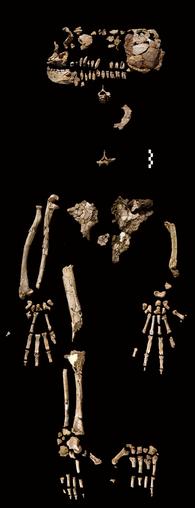Genus Ardipithecus
Introduction
Ardipithecus is the scientific name most commonly attributed to a group of bipedal apes who lived from about 4-6 million years ago, just after the divergence of humans and chimpanzees from their last common ancestor. The creatures attributed to the genus Ardipithecus are generally thought to be just on the human side of that initial fork in the family tree of humans and chimps.
The genus Ardipithecus was named in 1993.

Not a Knuckle-Walker
In a letter to Nature, entitled Evidence that humans evolved from a knuckle-walking ancestor, Brian G. Richmond and David S. Strait of George Washington University argue that analysis of the carpal morphology of Pr./Au. anamensis (KNM-ER 20419) and Pr./Au. afarensius (AL 288-1) demonstrate retained specializations associated with knuckle-walking, indicating a digitigrade quadruped ancestor for Pr�anthropus. (Richmond & Strait, 2000)
Retained from what? This is interesting because Ardipithecus, which lived closer to the date of divergence for Hominina and Panina, was not a knuckle-walker. Ardipithecus was most likely an arboreally plantigrade quadruped and a terrestrial plantigrade biped, making it unlikely to have been ancestral to a terrestrially digitigrade quadruped (like modern chimpanzees) that later spawned arboreally suspensory, terrestrial plantigrade bipeds (like the Australopiths). How and why evidence of knuckle-walking adaptations would have been retained in terrestrial bipeds who descended from terrestrial bipeds lacking such adaptations is currently somewhat of a mystery, to which molecular evidence of an interbreeding event between the ancestors of Panina and the ancestors of Hominina (Patterson, 2006) provides a valuable clue.
References
Richmond, Brian G. & David S. Strait. �Letters to Nature.� Nature 404 (23 Mar. 2000): 382-385 | doi:10.1038/35006045; Received 10 Aug. 1999; Accepted 10 Jan. 2000
<http://www.nature.com/nature/journal/v404/n6776/full/404382a0.html>

